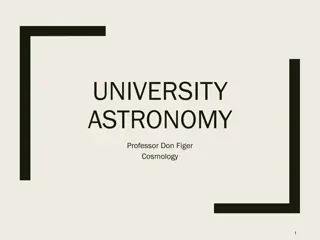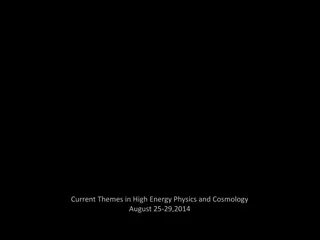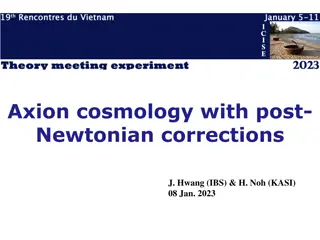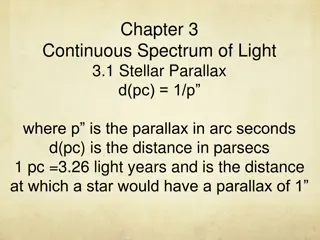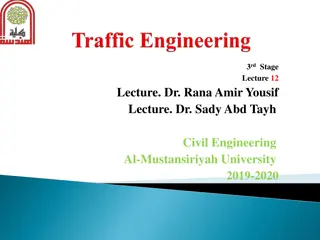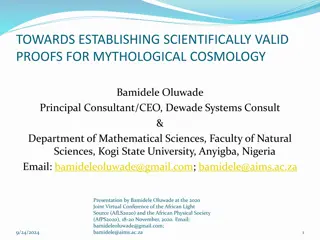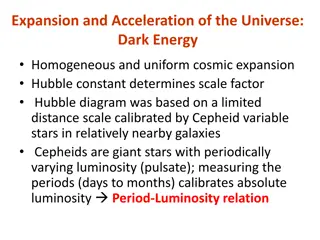Understanding Dark Energy and Luminosity Distance in Cosmology
Exploring the concepts of dark energy, luminosity distance, and how light travels through the universe at varying distances and redshifts. The formula and implications of distance measurements using Hubble's Law and luminosity distances are discussed, along with the impact of matter presence, universe curvature, and redshift on measuring distances in cosmology.
Download Presentation

Please find below an Image/Link to download the presentation.
The content on the website is provided AS IS for your information and personal use only. It may not be sold, licensed, or shared on other websites without obtaining consent from the author. Download presentation by click this link. If you encounter any issues during the download, it is possible that the publisher has removed the file from their server.
E N D
Presentation Transcript
Dark Energy Distance How Light Travels How far away something is gets complicated at high z How far it is now? How far it was then? How far light travelled? How distant it looks? ( ) ( ) 2 = + + + 2 2 2 2 2 2 2 2 sin ds c dt a d f d d The metric is We want to find the distance now d0 corresponding to some red shift z = = 0 d d Light will be coming to us along a constant and curve Light follows lightlike curves that is, ds2 = 0 = d dt c a = + a d 2 2 2 2 0 c dt
Finding the Distance to an Object = d dt c a ( ) ( ) ( ) t 2 = + + 2 2 2 2 2 2 sin ds a d f d d Useful, as before, to define x as the relative size of universe compared to now = d dt c 1 + a a = = x a x 1 z 0 0 And therefore dx dt = + 1 1 H x 0 Now, we previously found, if all we have is matter, then 1 cH d dx Dividing these, we have = 0 + 1 a x x 0 Integrate both sides The distance is a0 dx 1 0 d = 0 = 1 a cH ( ) 0 ( ) 1 + 1 z + 2 2 x x x
Understanding This Formula Qualitatively dx 1 = 0 = 1 d a cH ( ) 0 0 ( ) 1 + 1 z + 2 2 x x x 1 + Can we understand this formula? = 1 1 cH 1 1 d cH x 0 1 z ( ) 1 0 0 1 z + For small z, approximate integrand as 1 Rearrange and this is Hubble s Law 1 = d cH z cz H d 0 0 0 0 But the full formula includes corrections How does the presence of matter ( ) change things? As you increase , you have more gravity Universe decelerates more quickly Universe has less time since fixed red shift z Shorter distance for fixed z
Luminosity Distance: dx 1 = 0 = 1 d a cH ( ) ( ) ( ) t 2 = + + ( ) 2 2 2 2 2 2 sin ds a d f d d 0 0 ( ) 1 + 1 z + 2 2 x x x We actually don t measure the current distance d0 We get distances from standard candles We don t measure d0, we measure the luminosity distancedL: L = d L 4 b The distances d0 and dL differ in two ways: ( ) 2 ( ) = 2 0 2 4 A a f = 4 d f 2 0 2 The universe is curved Actual area of sphere is not 4 d2 = sinh The object has a large redshift 1+z Frequency decreases by 1/(1+z) Each photon has energy decreased by 1/(1+z) Rate at which photons are received decreased by 1/(1+z) if if if 1 1 1 ( ) = + 1 1 d z d 0 L sin
Type Ia Supernovae and Deceleration Measure luminosity distance dL as a function of redshift Compare to model for different values of : No model worked! Radiation only made it worse At modest z, it looked like the universe used to be expanding quicker! m = 0.0, = 0.0 m = 0.3, = 0.7 m = 0.3, = 0.0 m = 1.0, = 0.0
Dark Energy 2 2 8 a a kc a Friedmann Equation has density of stuff in the universe = G 2 2 3 = G a 2 2 2 a kc Multiply by a2 8 3 To match supernova data, we need this velocity increasing today To have speed increasing, must have a2 increasing with time Any matter which satisfies this constraint will be called dark energy Matter: (atoms, dark matter, neutrinos?) As universe expands, number of atoms decreases as a-3 So ~ a-3 Radiation: (light, neutrinos?, gravitons?) As universe expands, density of stuff decreases as a-3 Also, each photon gets red shifted to lower energy by factor a-1 So ~ a-4
Dark Energy: What is it? Vacuum Energy Density, aka Cosmological Constant: According to particle physics, empty space has stuff constantly appearing and disappearing This means empty space has energy associated with it: And therefore mass density Unfortunately, particle physicists aren t very helpful with calculating how much energy density u = + ? The density of the vacuum doesn t change as universe expands ~ 1, independent of a This contributes another term, the vacuum term to the energy density Its contribution is labeled 0.3 0.7 It was found that the data could be well fit with: m
Dark Energy vs. the Cosmological Constant 8 G c When Einstein first introduced his general theory of relativity, he first had what we now call Einstein s equations: = G T 4 He realized that this would describe a universe that was either contracting or expanding Hubble had not yet discovered Hubble s Law 8 G c To fix it, he introduced another term, which included the cosmological constant + = G g T 4 ( ) vac = (vac) T g Vacuum energy density, instead, introduces a new term in the stress-energy tensor: 8 G c ( ) vac = The two are equivalent if you set 4 There is no point in arguing which one is right
The CDM Model Dark Energy: What Does the Experiment Say? It depends on what assumptions we use: Assumption 1: Suppose we assume only that it behaves as a power law: an Including all data, experimental result: Note: normally given as w, where n = 3(1+w) n = 0.08 0.09 Assumption 2: Suppose we assume only that it is constant Including all data, experimental result: = 0.9993 0.0037 tot Assumption 3: Suppose we demand that it is constant, and tot = 1 Including all data, experimental result This model is called the CDM model It has become the standard model for cosmology stands for the vacuum energy density CDM stands for cold dark matter Cold is a term we will clarify later = = = 0.0490 0.0010 0.2607 0.0053 0.6889 0.0056 b d
Composition of the Universe H = 67.7 0.4 km/s/Mpc Dark Energy 0 26.07 t0 = 13.79 0.02 Gyr Dark Matter 0.14 = 1 4.9 Ordinary Matter Neutrinos 68.89
Age of the Universe, Round 3 (1) = = = = + 2 2 a a kc a = 2 0 G H 8 3 = G 8 3 m 0 i i 2 2 2 0 Assume: G H 8 3 0 m m 2 0 G H 8 3 Universe has only matter and dark energy 0 ( ) 2 2 0 2 01 kc a H m Dark energy density is constant Matter scales as a 3 kc2/a2 scales as a 2, of course Substitute in: a a ( ) 3 = 2 0 G H a a 8 3 0 m m = 2 0 G H 8 3 ( )( ) 2 2 = 2 2 2 0 1 kc a H a a ( ) ( )( ) 3 2 = + + 2 0 1 H a a a a 0 0 0 m m 2 Let x = a/a0: 2 1 dt dx = 1 H x x dx dt 0 ( ) + + 2 1 x x = + + 2 0 3 2 1 H x x m m m m 2 1 dx x = + + 2 1 H x x = 1 t H 0 m m 0 0 + + 2 1 x 0 m m
Age of the Universe, Round 3 (2) 1 dx x = 1 t H 0 0 + + 2 1 x 0 m m As m goes up, t0 goes down As goes up, t0 goes up If m + = 1, then 2tanh t H = 1 1 0 0 3 If = 0.6889, then = H = 1 13.8 Gyr 0.954 t 0 0 Compare oldest stars 13 1 Gyr Best estimate: 13.79 0.02 Gyr t = No Age Problem 0
What Dominates the Universe? 2 2 8 3 a k a c 2 2 8 3 ( ) a a kc a = + + G = G m r 2 2 a 2 2 What dominates it now? Matter: m = 0.31 (significant) Radiation r = 10 4 (tiny) Dark Energy: = 0.69 (dominant) Curvature kc2/a2: 1 tot < 0.01 (small) These change with time for two reasons: Scaling universe scale factor a changes Conversion: one type turns into another Stars cause matter radiation When were each of these dominant? How do each of these scale? Matter: Radiation: Dark Energy: 1 Curvature: Near Past Distant Past m a 3 r a 4 At any time, except maybe now, we can ignore curvature ( = 1) Future Never a 2 2 8 3 a a = G 2
The Future of the Universe G H 8 3 2 8 3 a a = 0 i = G i 2 0 2 Starting soon, we can ignore all stuff except vacuum energy density 2 8 3 2 G a ( 0 exp a t H t ( ) da dt a a a = = H a H = = 8 3G = 2 0 H 0 0 0 ) ( ) Universe grows exponentially The time for one e-folding of growth is This is longer than current age of universe H 1/2 = = 1 17.3 Gyr t 0 On the long time scale we are alone Except for Local group In a few 100 Gyr, rest of universe will look empty Red shifted to invisibility
Alternate Futures? Previous slide assumes that the dark energy is: Vacuum energy density (no scaling) Eternal (no decay) [this one probably true] We know very little about dark energy: If it scales as an, then n = 0.08 0.09 If n is small but negative: Universe expands as a power law, not exponential Functionally the same If n is small but positive: As universe expands faster and faster, gets bigger and bigger The faster it goes, the faster it accelerates In finite time, an, becomes infinite H becomes infinite All objects in the universe get ripped apart The Big Rip At least 100 Gyr in the future
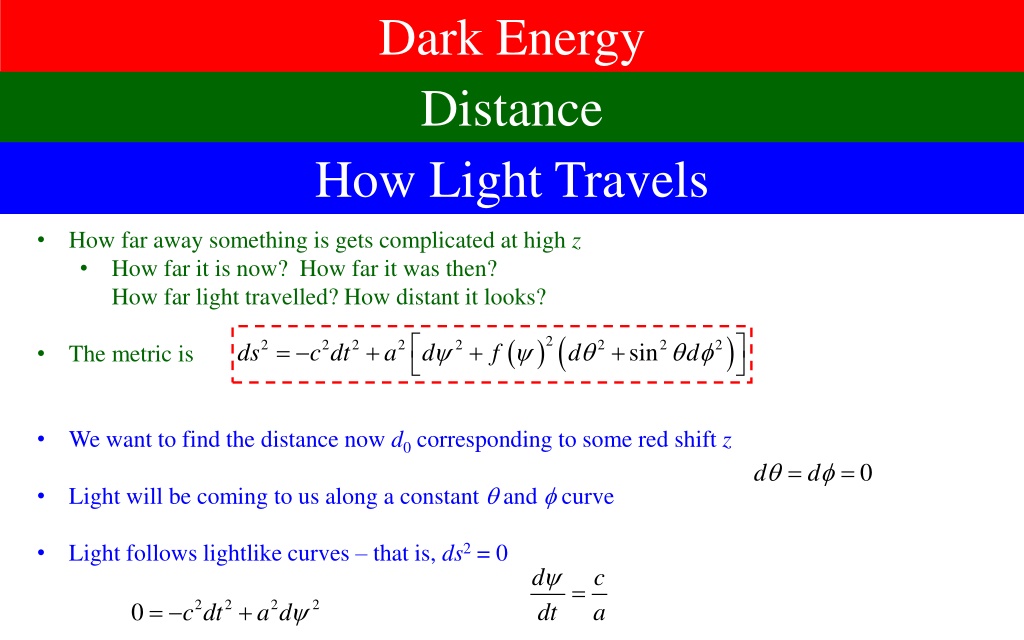


![[PDF⚡READ❤ONLINE] Cosmology and Particle Astrophysics (Wiley-Praxis Series in As](/thumb/21627/pdf-read-online-cosmology-and-particle-astrophysics-wiley-praxis-series-in-as.jpg)


